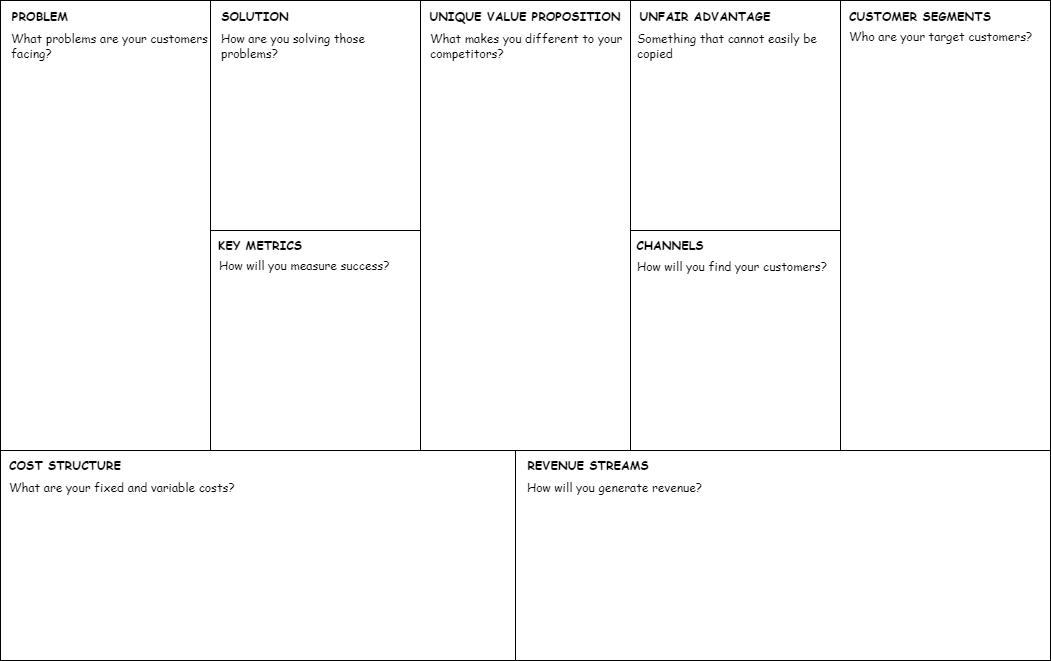How to validate your software business idea
Understanding and planning out your business model is vital for any venture. Alexander Osterwalder and Yves Pigneur introduced the Business Model Canvas as a way to visualize and shape a business idea. It provided a straightforward framework for laying out a business strategy on one page.
Ash Maurya, recognizing the importance of starting with a clear problem statement, especially for startups, developed the Lean Startup Canvas as a variant of the original Business Model Canvas. Instead of beginning with the solution, Maurya’s canvas starts with identifying the problem. It incorporates components like problems, solutions, key metrics, unfair advantage, and a unique value proposition. By focusing on identifying and understanding problems before jumping into solutions, the revised assessment approach can significantly increase the chances of a software business’s success.
This chapter will guide you on how to use the Lean Startup Canvas to define, refine and validate your software business idea, ensuring that it addresses a genuine market need.
The Lean Startup Canvas Explained

The Lean Startup Canvas consists of the following nine components:
- Problem: Identify and understand the top problems your customer is facing.
- Customer Segments: Define who your customers are, concentrating on the early adopters.
- Unique Value Proposition (UVP): Describe the unique benefit you offer your customers.
- Unfair Advantage: Highlight what makes you different and hard to copy or replicate.
- Solution: Propose how you plan to solve your customers’ problems.
- Channels: Determine how you will reach your customer segments.
- Revenue Streams: Establish how your business will make money.
- Cost Structure: Identify the costs to deliver your solution and run your business.
- Key Metrics: Determine the key indicators you will use to track your business’s success.
Filling in the Lean Startup Canvas
Here’s a step-by-step guide on how to fill in each component of the Lean Startup Canvas:
Problem
Start with the problem. You are in business to solve a problem, and without a well-defined problem, your software business lacks purpose. For each customer segment, identify the top 1-3 problems they face that your business seeks to address. These problems should be specific, measurable, and based on observations or market research.
Customer Segments
Now identify your customer segments. Be specific and aim to understand who your customers are in terms of demographics, psychographics, behaviors, and needs. Remember, it’s critical to focus on early adopters – those who are likely to take a chance on your new solution.
Unique Value Proposition (UVP)
Your UVP is the unique benefit you provide to customers that sets you apart from competitors. This isn’t a slogan or tagline, but a clear statement that articulates how you solve your customers’ problem and why you do it better than anyone else.
Unfair Advantage
What makes your business unique and difficult for competitors to copy? This could be proprietary technology, exclusive partnerships, personal authority, or any other advantage you possess.
Solution
Outline how your software or service offering addresses the problems identified earlier. Try to be concise, focusing on key features or services that directly correlate to the problems at hand.
Channels
These are the avenues through which you reach your customers.
Revenue Streams
Think about how you will generate revenue. Will it be through software sales, subscriptions, in-app purchases, consulting services, or some other method?
Cost Structure
What are the costs associated with running your business? Include costs for software development, marketing, staffing, infrastructure, and any other operating costs.
Key Metrics
Identify the critical indicators you will use to measure success. These could be customer acquisition costs, monthly recurring revenue, customer lifetime value, churn rate, or other KPIs relevant to your business model.
Validating Your Software Business Idea Using the Lean Startup Canvas
Once your canvas is filled out, it’s time to validate your assumptions. Engage with your defined customer segments through surveys, interviews, and market research to verify the accuracy of the problems, solutions, and unique value proposition you’ve identified.
Remember, the Lean Startup Canvas is a living document. As you gather feedback, be ready to iterate and refine your canvas accordingly. The aim is not to get it perfect on the first try, but to continually adapt and improve your business model based on real-world insights and experiences.
The Lean Startup Canvas will serve as your guide, enabling you to create a problem-focused, validated blueprint for your software business. As you move forward, you’ll delve deeper into elements of your business model, from perfecting your unique value proposition to establishing effective channels, and from managing your cost structure to optimizing your key metrics.